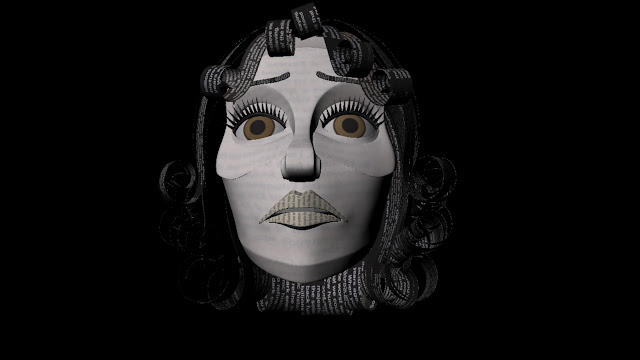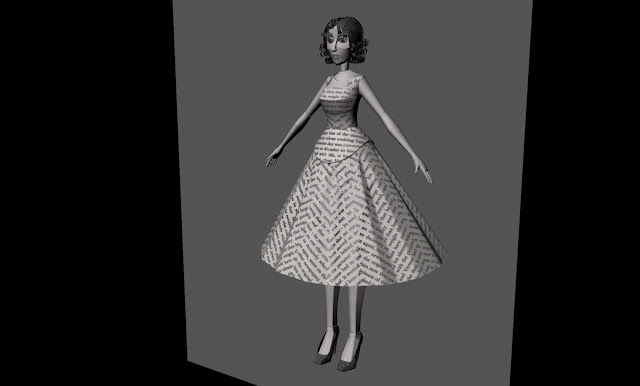I've been pondering how to give a less 'CG' look to my film so here's a link for future reference.
The clip of the rotating shape is ace.
http://area.autodesk.com/blogs/duncan/crosshatch_shading
Friday, 15 November 2013
Wednesday, 2 October 2013
Selection Highlighting
A very dumb problem that was getting to me yesterday. Highlighting on selected objects didn't show up in the perspective view (though it worked on front / side / top etc.)
I knew that I must have accidentally checked / unchecked a box somewhere but couldn't find it. I'm even sure that I tried the "show" menu in the persp view but I can't have been looking very carefully because it turns out that - when I looked again this morning - there it was!
So, to solve the problem: in whichever view you're having problems with go to the "show" menu and make sure that "selection highlighting" is checked. (In my case I had to uncheck and re-check it to get it to work.)
Hope that helps anyone else who's temporarily lost in maya menus :)
I knew that I must have accidentally checked / unchecked a box somewhere but couldn't find it. I'm even sure that I tried the "show" menu in the persp view but I can't have been looking very carefully because it turns out that - when I looked again this morning - there it was!
So, to solve the problem: in whichever view you're having problems with go to the "show" menu and make sure that "selection highlighting" is checked. (In my case I had to uncheck and re-check it to get it to work.)
Hope that helps anyone else who's temporarily lost in maya menus :)
Wednesday, 18 September 2013
Worried pacing movie reference
This is great reference for the writer's worried pacing, it captures some aspects of the character really well: stuck in a bedsit, worried about what's going on opposite outside the window.
The source was Getty Images - http://www.gettyimages.co.uk/detail/video/worried-man-sitting-at-table-pacing-to-bed-stock-video-footage/mr_00056042
Friday, 23 August 2013
mel scripts: select all anim curves & select all keys
These wee bits of mel have proved incredibly useful recently as I've been doing some shot layout:
This selects all animCurve nodes
select -r `ls -typ animCurve`;
This selects all keys on all animCurve nodes
selectKey`ls -typ animCurve`;
This selects all animCurve nodes
select -r `ls -typ animCurve`;
This selects all keys on all animCurve nodes
selectKey`ls -typ animCurve`;
Maya convert instance to object
My street environment was created with tons of instancing - including groups containing instances which were then instanced in turn. I'm not hugely familiar with instancing but it wound up creating problems in terms of flexibility of editing objects and general bugginess so I decided to convert the instances into objects in their own right.
This, it turns out, wasn't as easy as I might have thought.
I tried various methods including the menu item modify/convert/instance to object. My problem with using this is that you seem to need to do it in the 'correct order' otherwise instances of objects just disappear.
In the end the method I used is pretty labour intensive, but it works reliably without geometry going awol.
1) group all of the objects that you want to apply the instance-to-object conversion to - including all geometry that is (or in my case, might be ;) the originals of instanced geometry
2) using the outliner "expand all" in the group (shift and left click on the + sign next to the group)
3) select all items within the group
4) run this mel script duplicate -un
5) whilst the duplicated objects are still selected group and unparent them
6) delete the original group
7) repeat the above until all instances are objects (this is the labour intensive bit!)
This, it turns out, wasn't as easy as I might have thought.
I tried various methods including the menu item modify/convert/instance to object. My problem with using this is that you seem to need to do it in the 'correct order' otherwise instances of objects just disappear.
In the end the method I used is pretty labour intensive, but it works reliably without geometry going awol.
1) group all of the objects that you want to apply the instance-to-object conversion to - including all geometry that is (or in my case, might be ;) the originals of instanced geometry
2) using the outliner "expand all" in the group (shift and left click on the + sign next to the group)
3) select all items within the group
4) run this mel script duplicate -un
5) whilst the duplicated objects are still selected group and unparent them
6) delete the original group
7) repeat the above until all instances are objects (this is the labour intensive bit!)
Thursday, 4 July 2013
Margarita - Blend Shapes
Blendshapes for Margarita are coming together :)
Just have to tweak her smile a bit, and then polish all shapes so that they work together.
Here are a couple of expressions . . .
Monday, 1 July 2013
Tech Tips - symmetrical modelling with reflection in maya
OK, I can't decide whether I'm pleased to have found this or gutted that I'd already done so much modelling before I found it.
But I've finally figured out how to keep a model symmetrical when I make adjustments to vertices on one side.
Turns out that the move tool had a reflection setting all along! See the pic below for where to find it.
I'm looking forward to some happy modelling and much less "mirror geometry" from now on!
But I've finally figured out how to keep a model symmetrical when I make adjustments to vertices on one side.
Turns out that the move tool had a reflection setting all along! See the pic below for where to find it.
I'm looking forward to some happy modelling and much less "mirror geometry" from now on!
Tuesday, 16 April 2013
Maya - easily align vertices
1. Select your vertices
2. Select the move tool
3. Open the tool settings (click the SHOW OR HIDE TOOL SETTINGS button above the channel box)
4. Set it to WORLD SPACE and turn off RETAIN COMPONENT SPACING.
5. Hold X to snap to grid, then grab one of the move handles and move it.
Voila.
Thanks faultymoose http://forums.cgsociety.org/archive/index.php/t-425652.html
2. Select the move tool
3. Open the tool settings (click the SHOW OR HIDE TOOL SETTINGS button above the channel box)
4. Set it to WORLD SPACE and turn off RETAIN COMPONENT SPACING.
5. Hold X to snap to grid, then grab one of the move handles and move it.
Voila.
Thanks faultymoose http://forums.cgsociety.org/archive/index.php/t-425652.html
Maya - snap pivot to edge / vertex / grid
Select your object then hit the insert key. This lets you move the pivot around. Now the trick to get it aligned to an edge is to hold the C key then move you mouse cursor over to the edge you want to snap to. Click the middle mouse button and move the mouse slightly while holding the middle mouse button. The pivot will jump to the edge. While you have the middle mouse button held you can slide the pivot along the edge. You can also do this with the V key for snapping to vertexs and the X key to snap to grid.
Thanks pyromania: http://www.polycount.com/forum/showthread.php?t=37371
Thanks pyromania: http://www.polycount.com/forum/showthread.php?t=37371
Tuesday, 2 April 2013
Wednesday, 27 March 2013
Mental Ray Contour Shader
I need to start rendering again and realised that I'd pretty much forgotton how to render contours so here are some notes to myself for the rest of the shots :)
1) In render settings enable contour rendering. For my specific purposes I've also gone for hide source (I don't want any other textures, lighting etc visible in my contour layer - I'll comp those together later), flood colour is white (it could be anything, I'm going to key it out in the comp), over sample value of 30 (I need it this high to get reasonable quality and the render times are fine), gaussian filter and filter support of 2.
2) Pipe in "contour_contrast_function_levels" to Contrast Shader and "contour_store_function" into Store shader. (See below for where to find these in the hypershader.)
3) The settings I used for the contour_contrast utilitiy are below. To make sure I got the outlines I needed and to prevent broken lines, contours flickering on and off etc etc I went for diff mat which draws a countour line between different materials. This meant that I had to apply multiple materials to a single object, by applying individual shaders to the faces that I wanted to be outlined
4) For contours which get narrower with distance from the camera plug the "contour_shader_depthfade" utility into the shading group for the material
5) Starter settings for the depthfade utility are below. These need to be tweaked on a shot-by-shot basis depending on camera / lens etc.
I used tons of different resources to get this right but here's one that was pretty clear :)
http://wiki.bk.tudelft.nl/toi-pedia/Mental_Ray_Contour_Shader_tutorial
1) In render settings enable contour rendering. For my specific purposes I've also gone for hide source (I don't want any other textures, lighting etc visible in my contour layer - I'll comp those together later), flood colour is white (it could be anything, I'm going to key it out in the comp), over sample value of 30 (I need it this high to get reasonable quality and the render times are fine), gaussian filter and filter support of 2.
Tuesday, 12 February 2013
Paper Textures
Subscribe to:
Comments (Atom)













